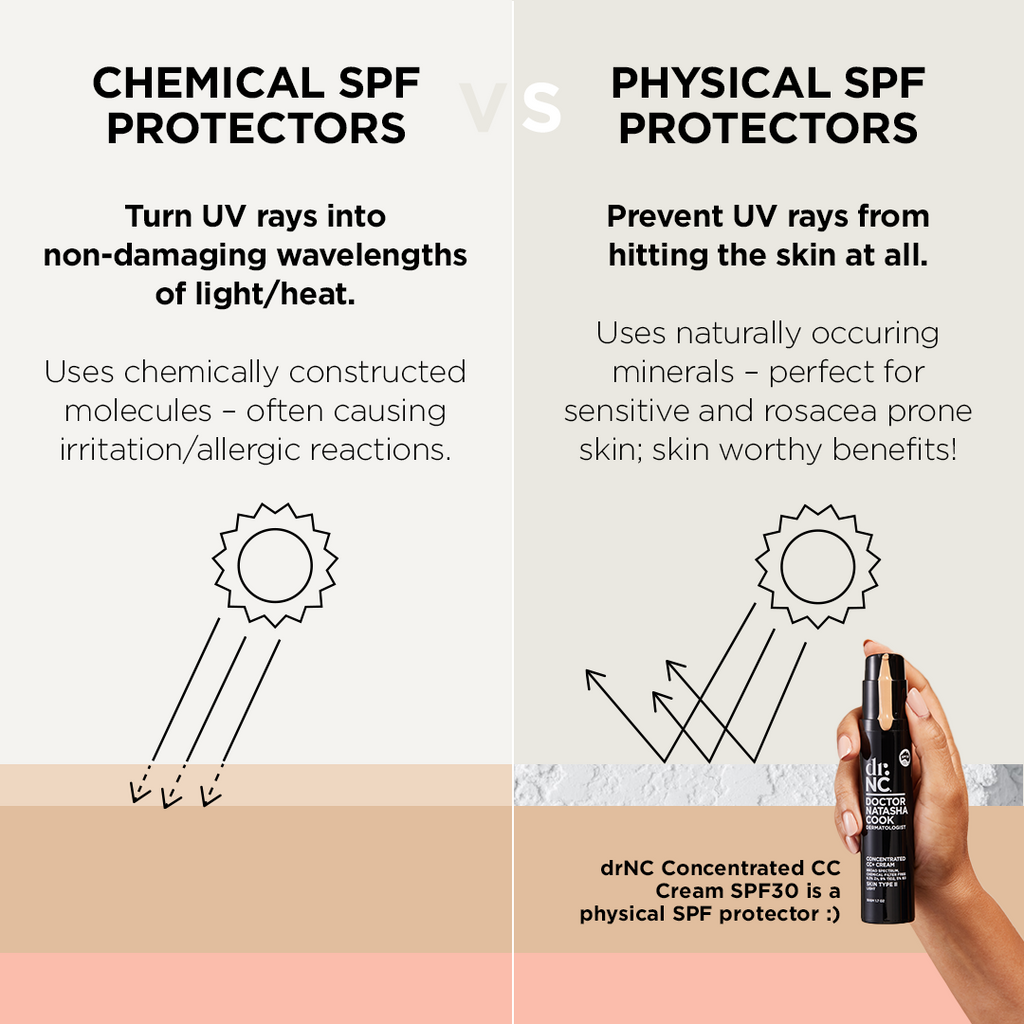
We all know that UV rays from the sun can be harmful to our skin. They can cause acne, freckles, wrinkles, and even skin cancer. But what you might not know is that when it comes to SPF UVA UVB sun protection there are 2 choices of ingredients that can protect your skin: physical blockers and chemical blockers.
These two categories of UV protectors have pros and cons, but one has a greater risk of harming your skin than the other (spoiler alert, it's the chemical one)!
Chemical SPF protectors will almost always end up leaving behind negative side effects on your complexion – even if they are labelled as ‘hypoallergenic’ or ‘natural’.
Physical UV protectors on the other hand will not only keep your skin safe from the dangers of sun exposure but also leave it looking younger with extended use!
Read on to learn why I choose physical over chemical sunscreen – first, let's cover off the basics of each type of sun protection:
Physical Blockers:
Zinc and titanium dioxide, which are naturally occurring minerals. They have no capacity for allergic or irritant reactions on the skin and also have additional skin worthy benefits. These are the safest choice for sensitive and acne prone skin.
Chemical Blockers:
These are chemically constructed molecules. Chemical sunscreens are synthetically made compounds that absorb the sun’s rays before they hit the deeper layers of the skin, preventing sun damage.
Although effective, they are responsible for all of the SPF filter allergic reactions, and irritancy, especially if you have sensitive skin or if you suffer from rosacea. They do not have any additional skin benefits outside of SPF protection.

When I was completing my dermatology training, I worked in Australia's leading Dermatology Contact Allergy Clinic at the Skin & Cancer Foundation, where I witnessed first hand skin reactions to SPF ingredients.
I am a published author in sunscreen reactions and sunscreen allergies. I therefore made a conscious decision to choose physical over chemical SPF protectors as I wanted the best, safest and ingredients that provide more than just SPF to the skin.
Over a decade of expensive and complicated research and development, my SPF 30 product, the Concentrated CC+ Cream SPF30, is proudly a chemical filter-free physical only sunscreen with the addition of antioxidants B3.
Concentrated CC+ Cream SPF30 contains BOTH zinc and titanium dioxide to protect the skin AGAINST both UVA and UVB, making it the best choice for all skin types especially for sensitive and acne prone skin.
A large percentage of SPF’s on the market are chemical sunscreens only. Largely because they’re cheaper and easier to formulate. But they can wreak havoc on sensitive skin.
It took me years to nail this formulation, because physical blockers can be tricky to create AND ARE FUNDAMENTALLY MORE EXPENSIVE.
No allergic reactions.
No sensitivity.
Just skin-loving protection and radiant colour-correcting coverage.

The Basics of Zinc Oxide
- A mineral ingredient – one of the best-known broad spectrum UV filters, especially UVA.
- Proven to be gentle enough for sensitive skin types (even infant skin and rosacea prone skin).
- It has multiple functions in cosmetics e.g. as a skin protectant and thickener.
- The broadest spectrum UVA and UVB reflector approved for use as a sunscreen by the FDA.
There have been concerns about using nano-sized zinc oxide in sunscreen over the recent years. Nanotechnology is simply taking a material and making it much smaller than its original size. For zinc oxide, nanotechnology makes it more aesthetically pleasing, as well as enhancing its SPF protection properties.
The good news is that zinc oxide nanoparticles are not believed to be a safety concern when applied to skin – a study published in the Journal of Investigative Dermatology found that zinc oxide nanoparticles don’t actually penetrate the skin OR cause any cellular damage, even with repeated applications. Further studies have found that nanosized zinc oxide is non-irritating in a similar way as non-nano zinc oxide.

The Basics of Titanium Dioxide
- It's used for thickening and opacifying, and as pigment and sunscreen ingredient.
- Protects against UVA and UVB rays.
- It's gentle, even for for sensitive OR redness-prone skin.
- Deemed safe for use in cosmetics products.
Titanium dioxide is an inert earth mineral. It protects skin from UVA and UVB radiation and is considered non-risky in terms of of skin sensitivity.
Micronised titanium dioxide doesn’t penetrate the skin; even if titanium dioxide nanoparticles are used, the molecular size of the nanoparticles coating is large enough to stop them from going beyond the uppermost layers of skin.
Since it is gentle, titanium dioxide is the perfect sunscreen active for sensitive, redness-prone skin. It can even be used around the eyes, as it is highly unlikely to cause stinging.
References
Zinc Oxide:
Journal of Investigative Dermatology, February 2019, pages 277-278
Nanomaterials, March 2017, pages 27-31
Particle and Fibre Toxicology, August 2016, page 44
International Journal of Cosmetic Science, June 2014, pages 273-283
Indian Journal of Dermatology, September-October 2012, pages 335-342
Archives of Toxicology, July 2012, pages 1063-1075
Photodermatology, Photoimmunology, & Photomedicine, April 2011, pages 58-67
American Journal of Clinical Dermatology, December 2010, pages 413-421
https://cosmeticsinfo.org >
Titanium Dioxide:
Journal of Cosmetic Dermatology, February 2021, pages 532-537
Frontiers in Bioengineering and Biotechnology, June 2020
Journal of Nanoparticle Research, March 2020
Journal of the European Academy of Dermatology and Venereology, November 2019, pages 34-46
Photodermatology, Photoimmunology and Photomedicine, November 2019, pages 442-446
Journal of Cosmetic Science, September 2019, pages 223-234
Materials, July 2019, pages 1-24
Photodermatology, Photoimmunology, and Photomedicine, April 2011, pages 58-67
Skin Therapy Letter, July-August 2008, pages 5-7
Environmental and Health Perspectives, July 2008, pages 893


























